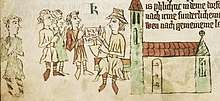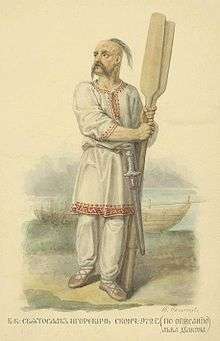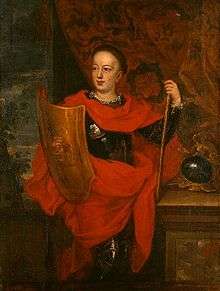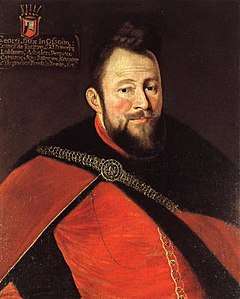Czupryna
The Polish halfshaven head (Polish: czupryna, podgolony łeb, łaszczówka) is a traditional Polish noble haircut, associated mainly with sarmatism, but worn by Poles in the Middle Ages too. It is marked by shaving hair above the ears and on the neck on the same height, with longer hair on the top of the head. For hundreds of years it was typical of Poles.


History
The origins of the halfshaven head are not clear. It was worn probably before the 12th century until its slow disappearance in the 18th century. The earliest mentions of the "Polish halfshaven head" from the Middle Ages were written by f. ex., an anonymous Franciscan in 1308,[1] Wincenty from Kielcza[2] (half of 13th century), and Austrian poet Zygfryd Helbling (end of 13th century)[3][4] who was swearing on Polish and Czech influences. In chronicles of Mierzwa (beginning of 14th century) from Cracow, we can also read that Prince Leszek the Black (died in 1288) grew his hair to ingratiate himself with Germans, so it was a scandal both in his times and in times of chronicle. In graphic sources there are paten (half of 13th century) from Płock cathedral founded by Konrad Mazowiecki, and the paten founded by Mieszko the Old (year 1195)[5] to the monastery of Cistercians in Ląd, and floor from Wiślica (years 1175-1180).[6]
Halfshaven head and the other Slavs
Wends
It's possible that not only Poles, but also other Slavs worn a halfshaven head. British Franciscan Bartholomeus Anglicus in year 1235 wrote in his encyclopedia, that mostly all the Slavs, except Ruthenians and Slavs mixed with Germans and Latins, shave their heads.[7] Bartholomeus, who lived in Magdeburg from several years know good the Slavic lands.[8] By "Slavic lands" he meant the area from Saxonia to Ruthenia and from Dalmatia, Carinthia and Serbia to the Baltic Sea. About shaven heads, and dislike to beards, wrote also Saxo Grammaticus when writing about the temple of Arcona.[9] He wrote that according to the common custom, only priests could grow long hair and beards.[10] In a Saxon manifesto against Slavic pagans from year 1108 is mentioned that Slavs simulated Saxons during the attack by wearing their scalps[11] - Saxons grew long hair,[12] so Polabian haircut had to be very different: very short. So, the custom of shaving hair, in 13th century recognised as Polish, has to have bigger dimensions. The existence of czupryna amongst the Polabian Slav territories is obviously testified by many archaeological discoveries. Are for example: little bronze statue for Schwedt/Oder (X-11th century),[13][14] Altfriesack Götze, a wooden statue from Altfriesack (6th-7th century),[15] sitting statue from Gatschow near Demmin (XI-12th century),[16] a little sculpture from Merserburg near Leipzig (10th century).[17] All the figures have short hair and halfshaven heads. There are also a metal fitting from museum in Oldburg and a wooden statue from Wolin (10th century). Because of the corrosion, it is difficult to say if heads are shaven, but the hair are surely short.[18][19] The most clear proof are the Sachsenspiegel illustrations - all Wends on the illustrations (in contrast with long-haired Saxons) have a short haircut, shaved at the ear-height.
South Slavs
In old Croatian tombs razors are often found too, but the problem about dimensions of halfshaven head custom in other Slavic lands than Poland is still not investigated.[20] Another, but similar custom, is the so-called перчин / perčin (in Serbo-Croatian) or чумбас / чембас (in Bulgarian). It's a haircut that consist in shaving head from below, like in czupryna, but with leaving an braid of hair or something like Ukrainian chub. This haircut probably arrived from Asia with Proto-Bulgars: for the first time, "shaven heads" were mentioned in the Nominalia of the Bulgarian khans. It was worn by South Slavs still in the 19th century.[21][22][23][24]
Cossacks

The halfshaven haircut was also worn by the Cossacks of the Ukraine from the 15th to the 21st century. Known as a Chupryna or Oseledets due to its resemblance to a herring, it featured a long strip of hair on the top of an otherwise shaven head. Russians commonly use the word khokhol (Russian: хохо́л), meaning forelock, as an ethnic slur for Ukrainians. The term is frequently derogatory or condescending, an equivalent of the Ukrainian term katsap (Ukrainian: кацап) and Polish kacap for Russians.[25][26]
Types of halfshaven head
Among centuries in Polish literature we can see a specialised nomenclature about czupryna. It's possible to distinguish various types:
- czupryna (staro)polska – the (old-)Polish halfshaven head. This is the oldest type of halfshaven head, we can see it in medieval sources, we know that Jan III Sobieski wore this type of czupryna too.
- czupryna łaszczowa – the łaszcz's halfshaven head. This is the type of czupryna connected with the person of Samuel Łaszcz, which, according to sources, popularised this type. In czupryna łaszczowa type, the shaving was higher.
- czupryna czerkieska – the cherkess halfshaven head. From the name, we can deduce that this type was probably similar to the traditional cherkess male haircuts.
- czupryna szwedzka – the swedish halfshaven head. According to the sources the shaving was lower, more similar to the Order of Saint Benedict tonsure, and sprinkled with powder.
- głowa cybulana – the onion-like head. That's an playful name for a trend to reducing czupryna to some hair at the top of the head.[27][28]



References
- Anonymi descriptio Europeae Orientalis, wyd. O. Górka, Kraków 1916, s. 57–58: olim omnes Poloni ibant tonsi, sicut conversi cistercienses, sed nunc aliqui incipiunt dimittere crines.
- Vita minor, cap. 24, MPH IV, s. 272: Ob cuius dispesacionis beneficium ac recordacionis memorabile signum indictum est Polonis, ut in tonsura rotunda conformarent se moribus religiosorum; to samo powtarza Vita maior, cap. 12, MPH IV, s382. Kontrowersje wokół datowania żywotów nie mają, według Jurka, znaczenia, gdyż dotyczą kilku lat, czyli około roku 1248 lub około 1254, zob. M. Plezia, Dookoła sprawy świętego Stanisława. Studium źródłoznawcze, wyd. 2, Bydgoszcz 1999, s. 138.
- Seifrief Helbling, Der Kleine Lucidarius, III 225 n. Wyd. J. Seemüller, Halle 1886 (reprint 1987), s. 123: Waz will du Pôlân hôchbeschorn?/der Ungern waere daz vil zorn/ der ir langem hâr erkür/die hôhen pôlânischen schüer. Pieśń trzecia powstała, według ustaleń wydawcy (s. XX), w latach 1292-1294.
- Ibidem, VIII 793n., s. 210 n.: und swer in disem lande snit/gewant nâch der Pôlân sit,/ daz dem sin hâr waer geschorn / hôch úf für die ôrn/ daz sold im nimer washen. Pieśń iVIII pochodzi z 1299 r.
- Sztuka polska przedromańska, il. 1058; P Skubiszewski, Patena kaliska, Rocz. Hist. Szt. 3 (1962), s. 158-213; do datacji por. T. Jurek, Dokumenty fundacyjne opactwa w Lądzie, Rocz. Hist. 66 (2000), s. 34; barwna reprodukcja w: Cystersi w średniowiecznej Polsce. Kultura i sztuka. Katalog wystawy, Warszawa-Poznań 1991, s. 142–143, 146–147.
- Sztuka polska przedromańska, il. 696, 703; L. Kalinowski, Romańska posadzka z rytami figuralnymi w krypcie kolegiaty wiślickiej, w: Odkrycia w Wiślicy. Rozprawy Zespołu Badań nad Polskim Średniowieczem Uniwersytetu Warszawskiego i Politechniki Warszawskiej, t. I, Warszawa 1963, s. 86–110; J. Leśny, w: SSS, t. VI, Wrocław 1980, s. 497-499 (z bibliografią); J. Dobosz, Polityka fundacyjna Kazimierza Sprawiedliwego, Poznań 1995, s. 54-57 (gdzie uściślenie ramowych dat powstania oraz zestawienie literatury).
- A. E. Schönbach, Des Bartolomeus Anglicus Beschreibung Deutschlands gegen 1240, Mitteilungen des Instituts für österreichsche Geschichstforschung 27 (1906), s. 54-90, tu s. 71: qui omnes se intelligunt et in multis sunt similes, quo ad linguam et quo ad mores, dispares tamen quo ad ritum, – omnes etiam isti pro maiori parte in coma sunt attonsi, exeptis Ruthenis et ilis, qui mixti sunt cum Teutonicis et Latinis. Fragment tekstu z późnośredniowiecznego wyciągu wydał W. Kętrzyński w MPH VI, s. 587-588, zamiast attonsi dając jednak accensi (zapalczywi?).
- Lexikon des Mittelalters, t. I kol. 1492-1493; por. Też A. F. Grabski, Polska w opiniach obcych X-XIII w., Warszawa 1964, s. 95 i n.
- Saxo Grammaticus, Gesta Danorum, lib. XIV, cap. 39,3, wyd. J. Orlik, H. Raeder, t. I, Hauniae 1931, s. 645: Corrasae barbae, crines attonsi figurabatur, ut artificis industriam Rugianorum ritum in cultu capitum aemulatam putares.
- Ibidem, cap. 39,4: sacerdos praeter communem patriae ritum barbae comaeque prolixitate spectandus.
- Urkundenbuch des Erzstifts Magdeburg, wyd. F. Israel, Magdeburg 1937, nr. 193: Quamplures vivos excoriant et cute capitis abstracta hoc modo larvati in christianorum fines erumpunt et se christianos mentientes predas impune abigunt; przedruk: G. Labuda, Fragmenty dziejów Słowiańszczyzny Zachodniej, t. III, Poznań 1975, s. 233-236 (cytat s. 234); tamże obszerna dyskusja na temat tego zabytku. Na ustęp ten zwrócił uwagę S. Trawkowski, w: Kultura Polski średniowiecznej X-XIII w., s. 64.
- Por. choćby u Widukinda lib. I cap. 9:mirati sunt Franci – diffusos scapulas caesarie [Saxones].
- http://www.lda-lsa.de/landesmuseum_fuer_vorgeschichte/fund_des_monats/2009/dezember/ ilustracja Abb.3
- http://www.lucivo.pl/2012/09/bawany.html
- http://www.lucivo.pl/2012/09/bawany.html Zdjęcia głowy: http://swinow.livejournal.com/58500.html
- http://lucivo1.rssing.com/browser.php?indx=7563107&item=11%5B%5D Link do szkicu(Abb.6): http://www.lda-lsa.de/landesmuseum_fuer_vorgeschichte/fund_des_monats/2012/januar/
- http://www.lda-lsa.de/landesmuseum_fuer_vorgeschichte/fund_des_monats/2012/januar/
- http://lucivo1.rssing.com/browser.php?indx=7563107&item=11%5B%5D
- http://www.lda-lsa.de/landesmuseum_fuer_vorgeschichte/fund_des_monats/2012/januar/ Fotografia Abb.4
- Cf. Maja Petrinec, Gräberfelder aus dem 8. bis 11. Jahrhundert im Gebiet des fruehmittelalterlichen kroatischen Staates, Split: Museum der kroatischen arcäologishen Denkmäler, 2009.; Vladimir Sokol, Hrvatska srednjovjekovna arheološka baština od Jadrana do Save, Zagreb: Cf. i Srednjovjekovni kostim na području stare hrvatske države, tekst kataloga Magdalena Dragičević, predgovor kataloga Vesna Čulinović-Konstatinović, autor fotografije Zlatko Sunko, Split: Muzej hrvatskih arheoloških spomenika, 1988.
- http://www.sarakt.eu/vzhled.htm
- http://arhiv.slobodnadalmacija.hr/20040325/mozaik03.asp
- http://www.kravatpukovnija.com/o-nama/ Sentence:"Pod orijentalnim utjecajem često su brijali glave ostavljajući na vrhu samo perčin kose."
- https://issuu.com/imota/docs/bih_katolici_i_turski__per_in_na_glavi_-_slike__19
- Thompson, Ewa Majewska (1991). The Search for self-definition in Russian literature. 27. John Benjamins Publishing Company. p. 22. ISBN 90-272-2213-4.
- Stamerov K. History of Ukrainian costume: from the Scythian period to the late 17th century. Melbourne: Bayda Books, 1986 - 62 p. ISBN 0-908480-16-4, ISBN 978-0-908480-16-6 (Page 47)
- https://pl.wikisource.org/wiki/Encyklopedia_staropolska/Czupryna
- https://pl.wikisource.org/wiki/O_strojach_czyli_sukniach